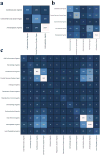Deep Learning Applications for Predicting Pharmacological Properties of Drugs and Drug Repurposing Using Transcriptomic Data
- PMID: 27200455
- PMCID: PMC4965264
- DOI: 10.1021/acs.molpharmaceut.6b00248
Deep Learning Applications for Predicting Pharmacological Properties of Drugs and Drug Repurposing Using Transcriptomic Data
Abstract
Deep learning is rapidly advancing many areas of science and technology with multiple success stories in image, text, voice and video recognition, robotics, and autonomous driving. In this paper we demonstrate how deep neural networks (DNN) trained on large transcriptional response data sets can classify various drugs to therapeutic categories solely based on their transcriptional profiles. We used the perturbation samples of 678 drugs across A549, MCF-7, and PC-3 cell lines from the LINCS Project and linked those to 12 therapeutic use categories derived from MeSH. To train the DNN, we utilized both gene level transcriptomic data and transcriptomic data processed using a pathway activation scoring algorithm, for a pooled data set of samples perturbed with different concentrations of the drug for 6 and 24 hours. In both pathway and gene level classification, DNN achieved high classification accuracy and convincingly outperformed the support vector machine (SVM) model on every multiclass classification problem, however, models based on pathway level data performed significantly better. For the first time we demonstrate a deep learning neural net trained on transcriptomic data to recognize pharmacological properties of multiple drugs across different biological systems and conditions. We also propose using deep neural net confusion matrices for drug repositioning. This work is a proof of principle for applying deep learning to drug discovery and development.
Keywords: DNN; confusion matrix; deep learning; deep neural networks; drug discovery; drug repurposing; predictor.
Figures



References
-
- Loging W, William L, Lee H, Bryn W-J. High-Throughput Electronic Biology: Mining Information for Drug Discovery. Nat Rev Drug Discov. 2007;6(6) - PubMed
-
- Kirchmair J, Johannes K, Göller AH, Dieter L, Jens K, Bernard T, Wilson ID, Glen RC, Gisbert S. Predicting Drug Metabolism: Experiment And/or Computation? Nat Rev Drug Discov. 2015 - PubMed
-
- Schirle M, Markus S, Jenkins JL. Identifying Compound Efficacy Targets in Phenotypic Drug Discovery. Drug Discov Today. 2015 - PubMed
-
- LeCun Y, Yann L, Yoshua B, Geoffrey H. Deep Learning. Nature. 2015;521(7553):436–444. - PubMed
-
- Baldi P, Sadowski P, Whiteson D. Searching for Exotic Particles in High-Energy Physics with Deep Learning. Nat Commun. 2014;5:4308. - PubMed
MeSH terms
Grants and funding
LinkOut - more resources
Full Text Sources
Other Literature Sources

